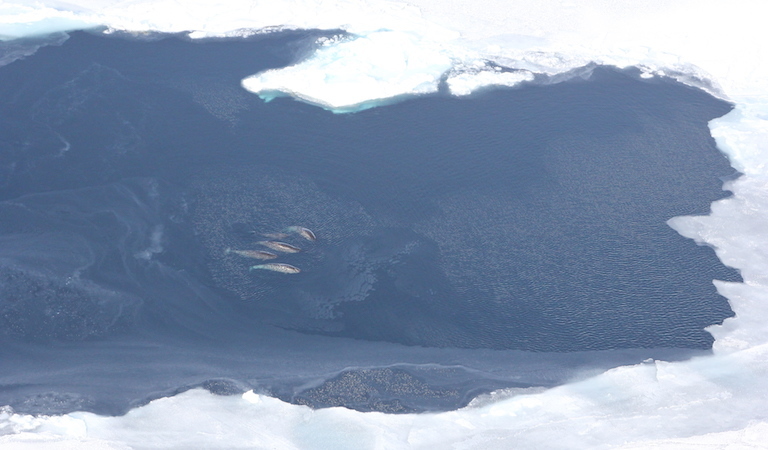Don’t bother trying to attach radio transmitters to narwhals, the “unicorns of the sea,” says marine ecologist Kristin Laidre.
These tusked Arctic whales are so hard to find they might as well be actual unicorns.
“They’re one of the worst study animals ever,” said Laidre, who tagged narwhals to gather data on their icy environment. “They’re just really, really difficult. They are shy, they are elusive, they are sneaky. You can spend a month in the field and barely see a narwhal.”
Still, the narwhals have become unlikely allies in NASA’s efforts to understand Greenland’s rapidly changing ice sheet. In a cooperative arrangement meant to improve understanding of both narwhal behavior and melting glaciers, the data gathered by tagged narwhals will help fill an important scientific goal in a NASA project called Oceans Melting Greenland (OMG).
This multipronged endeavor seeks precision data on where, how, and how fast the relatively warm ocean waters are melting Greenland’s ice. NASA is attacking the problem by ship, plane and floating sensor.
But measuring the ocean near Greenland’s glaciers can be a major challenge even from a ship because of heavy sea ice and fjords choked with icebergs. That’s where the narwhals come in.
“In the summer, the sea ice melts away and narwhals migrate to remote fjords in Melville Bay” in northwest Greenland, said Ian Fenty, a NASA oceanographer who studies sea level and ice. “Narwhals spend time feeding in the waters in front of the glaciers – exactly where we need ocean measurements for OMG.”
Scientists — with fins
Much of the Greenland coast is ice-free only a few times a year – a major barrier to scientific investigation of ice melt and ocean-water variability.
“Very few people live in northwest Greenland and so historically very little of the ocean has been mapped up there,” Fenty said. “There’s a huge data hole that we need to fill to learn why the glaciers in that region are melting.”
So when Fenty learned of a paper Laidre published in 2010, using data from narwhals to show continued warming in Baffin Bay west of Greenland, the partnership was born.
During brief captures using nets, Laidre and colleagues had attached sensors to blubber and cartilage on the backs of 14 narwhals between 2005 and 2007. Once released, the narwhals gathered data on temperature, salinity and depth, diving to the sea floor as far as nearly 6,000 feet (1,800 meters) below.
“We let the narwhals be the oceanographers,” Laidre said.
Combined with temperature measurements from sensors dropped by helicopter, the narwhal data revealed that a warming trend seen in previous years in Baffin Bay continued through 2007.
“It’s super interesting,” Fenty said. “These whales go everywhere in Baffin Bay. Even when the ocean is covered in sea ice, they survive, they find air holes.”
Fenty reached out to Laidre and asked to use her narwhal data to round out OMG measurements of temperature, salinity and ocean depth along the Greenland coast – essential to unraveling the intricate relationship between warming water, melting ice and Greenland’s coastal fjords.
While the 2010 paper focused on measurements in Baffin Bay waters well to the west of Greenland, the narwhals had to be tagged close to the coast, where they also gathered data.
That was the data gap Fenty wanted to fill – from otherwise inaccessible locations.
So NASA and the Office of Naval Research have agreed to jointly fund a new study, focusing both on narwhal behavior and changes in Arctic ice.
Reading clues from narwhals' travels
Acoustic monitoring sensors and land-based cameras in three fjords in Melville Bay will track narwhal presence to better understand how narwhal behavior relates to ocean and ice variations.
“Not only will scientists learn about how warming oceans are melting Greenland but this project will also provide scientists like Kristin more data about how narwhal behavior is linked to ocean temperature, salinity, and ice conditions in the fjord,” Fenty said.
Moored instruments also will make frequent measurements of ocean temperature and salinity to enhance OMG data and improve computer modeling of ocean circulation and glacial melting.
Narwhals can dive to great depths. By looking at how deep the narwhal “oceanographers” have dived in the past scientists can get a better sense of just how deep the ocean is.
“I’m hoping that the narwhal dive-depth data will fill out some of the gaps in our bathymetry (sea-floor) measurements made during the OMG mission,” Fenty said.
Read the published paper, "Narwhals document continued warming of southern Baffin Bay"



